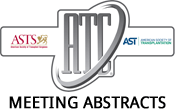2016 American Transplant Congress
Ischemia Reperfusion Induced Murine Heart Transplant Rejection Is Complement Dependent.
Increased posttransplant ischemia reperfusion injury (IRI) prevents costimulatory blockade induced heart graft survival but mechanisms linking innate and adaptive immunity are poorly understood. Based on…2016 American Transplant Congress
HO-1/SIRT1/p53 Axis Regulates Macrophage Activation and Attenuates Liver Ischemia-Reperfusion Injury in Mice.
Background/Aim: The mechanism by which macrophage heme oxygenase-1 (HO-1)-Sirtuin1 (SIRT1) signaling promotes resistance against inflammation response in liver ischemia-reperfusion injury (IRI) remains elusive. As tumor…2016 American Transplant Congress
Subnormothermic Machine Perfusion (SNMP) Leads to Increased Bile Production and Secretion of Hydrophilic Bile Acids After Liver Transplantation When Compared to Cold Storage (CS).
University of Pittsburgh, Pittsburgh.
Background: Bile production during machine perfusion and after transplantation has been used as marker of liver allograft viability and function. This study aimed to assess…2016 American Transplant Congress
Machine Perfusion (MP) at 21[deg]C Simulates Hibernation Metabolic Pathways in a Non-Hibernator Mammal.
University of Pittsburgh, Pittsburgh.
Background: Hibernation is a complex and multi stage process that leads to unique metabolic changes over an extended period of time. Regulatory genes and transcription…2016 American Transplant Congress
Cold Storage Stabilization of Gap Junctions Reduces Post Transplant Ischemia Reperfusion Injury.
Purpose: Organ procurement, cold storage and ischemia reperfusion injury (IRI) promote inflammation, which induces endothelial cell (EC) activation and dysfunction post transplantation. EC gap junctions…2016 American Transplant Congress
Early Alloantibody Responses Against Donor MHC Class I and Class II Molecules Are Differentially Affected by Prolonged Cold Ischemia Storage of Renal Allografts.
Immunology, Cleveland Clinic Foundation, Cleveland, OH.
Prolonged cold ischemia storage (CIS) of donor transplants is a major risk factor for acute and chronic graft tissue injury. Despite strong clinical correlations between…2016 American Transplant Congress
Serelaxin Decreases the Severity of Cold Ischemia-Reperfusion Injury After Liver Transplantation in Mice.
The Dumont-UCLA Transplantation Center, UCLA, Los Angeles, CA.
Background. Extended cold preservation contributes to ischemia-reperfusion injury (IRI), which impairs graft function and leads to poor clinical outcomes. Serelaxin (SER), a recombinant form of…2016 American Transplant Congress
Combination of Veto Cell Transfer and iNKT Cell Therapy Establishes Complete Hematopoietic Chimerism in Non-Myeloablative BMT Recipients.
Hematopoietic chimerism after non-myeloablative bone marrow transplantation (nmBMT) has been found beneficial for establishment of transplant tolerance. Since bone marrow cells (BMCs) are endowed with…2016 American Transplant Congress
Post Transplantation High-Dose Cyclophosphamide Treatment Promotes Immune Tolerance After Skin, Solid Organ, and Vascularized Composite Allotransplantation.
Background: Developing novel approaches to minimize/avoid immunosuppression by induction of immune tolerance represents the prime task in the field of transplantation. Methods: Murine skin, heart,…2016 American Transplant Congress
Tolerogenic Interactions Between Host CD8+Myeloid Dendritic Cells and Natural Killer T Cells Are Required for Acceptance of Combined Organ and Bone Marrow Transplants After TLI Conditioning.
Combined transplantation of solid organs and bone marrow or hematopoietic progenitor cells has resulted in successful achievement of tolerance in both laboratory animals and in…
